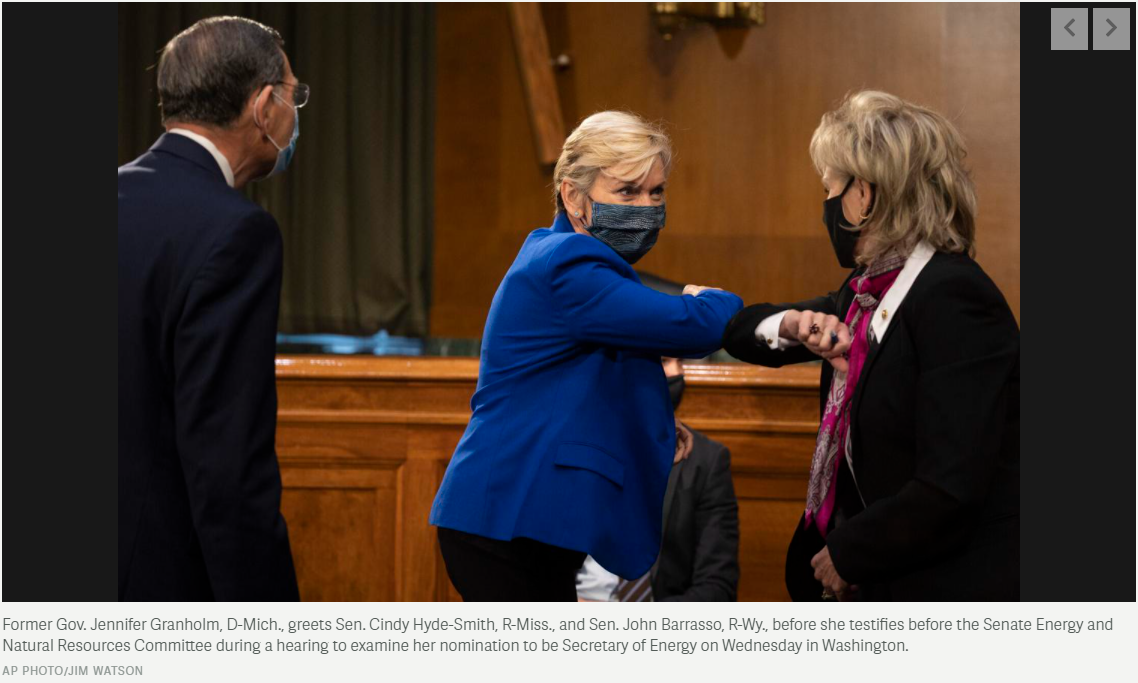Source: Aiken Standard
By Colin Demarest
In written testimony provided to a Senate panel Wednesday, the new president’s pick to lead the Department of Energy said she would prioritize, among other things, American safety and security.
Doing so, Jennifer Granholm explained in a single paragraph, would mean focusing on the department’s offensive-and-defensive arm, the National Nuclear Security Administration, as well as the cleanup of Cold War artifacts – pockets of toxic waste, for example, trapped at sprawling installations like the Savannah River Site south of Aiken.
During her confirmation hearing this week, before the Senate Energy and Natural Resources Committee, the latter was discussed at decent length; the Hanford Site in Washington, notoriously difficult and expensive to remediate, was brought up several times, and Granholm pledged not to kick the can down the road. Some might argue such remarks are a rite of passage for Energy Department executives.
The former – the National Nuclear Security Administration, its hefty budget and its myriad missions – was sparsely touched, even with Granholm cracking open the door.
The disconnect, though, didn’t catch observers off guard.
“Given the committee in which the confirmation hearing took place and the fact that she’s not yet up to speed on nuclear weapons issues, it’s no surprise that Gov. Granholm was not asked about key NNSA issues,” said Tom Clements, the director of Savannah River Site Watch, an organization that monitors a host of energy- and nuclear-related issues. “I assume she is receiving briefings on NNSA matters and will soon be fully conversant and able to make informed, sound decisions.”
The committee that handled Granholm’s nomination has jurisdiction over nuclear waste, not nuclear weapons – exactly why Sens. Maria Cantwell of Washington and Ron Wyden of Oregon broached Hanford and why Sen. Catherine Cortez Masto of Nevada railed against Yucca Mountain.
“I wouldn’t want to read the tea leaves too much,” said Marylia Kelley, the executive director of Tri-Valley CAREs, which tracks Lawrence Livermore National Laboratory and the nuclear-weapons complex, more broadly. “I do know that after the hearing I was left with questions.”
The hearing Wednesday, shy of three hours, served as a digestible introduction to Granholm, a two-time governor of Michigan, auto-industry adept and clean-energy advocate. The conversation was heavy on energy sources and fuels, climate change and job losses, a major concern for some lawmakers as President Joe Biden signs a flurry of environmental executive orders. Kelley, though, is anxious to see where the nominee stands on nuclear-weapons issues: new warheads, new cores, modernization spending and the like. Such topics are a rarity on governors’ desks.
“I am hopeful that our new energy secretary will bring a set of skills that will help her make difficult decisions under pressure in a logical and organized fashion,” Kelley said. She later added: “Of course, from my organization’s perspective, I will be looking toward the Energy Department being more skeptical about expanding pit production, both on the question of what we need and on the question of when we need it, and how much we’re going to spend on it and how we’re going to accomplish it. I’m looking for her to be skeptical.”
Indications of priority – what’s important, and how much – will unfurl in budget requests and related budget hearings, said Nickolas Roth, the director of the nuclear security program at the Stimson Center, headquartered in Washington, D.C.
“That’s where you usually get more into the weeds on this kind of stuff,” Roth said. His hope, he explained, “is that the Biden administration will look for ways to curtail a very expensive nuclear-weapons modernization program” and strike a better balance with the nonproliferation portfolio.
If confirmed, Granholm would take the reins at a department very much devoted to the U.S. nuclear arsenal.
“The National Nuclear Security Administration is the largest part of the budget when you figure that environmental management is related to the nuclear weapons mission,” Kelley said. “It’s the lion’s share of the budget, by far.”
The Energy Department’s fiscal year 2021 budget request added to $35.4 billion; the National Nuclear Security Administration earmark totaled $19.8 billion. Of that sum, a vast majority was for weapons activities. (Daryl Kimball, the executive director of the Arms Control Association, has branded the DOE as the NWD: Nuclear Weapons Department.)
In the weeks before the 2021 blueprint was unveiled, dozens of lawmakers, including three Palmetto State Republicans, lobbied then-President Donald Trump to funnel more money to the NNSA and its weapons work. Insufficient funding, the elected officials wrote, would risk U.S. national security and embolden “anti-nuclear Democrats who oppose your effort to rebuild our military,” a red meat appeal.
Clements, who leads SRS Watch, anticipates Granholm “will make tough decisions reshaping U.S. nuclear weapons policy in a way that increases our collective security while reducing financial costs and reducing reliance on nuclear weapons.”
That remains to be seen.

